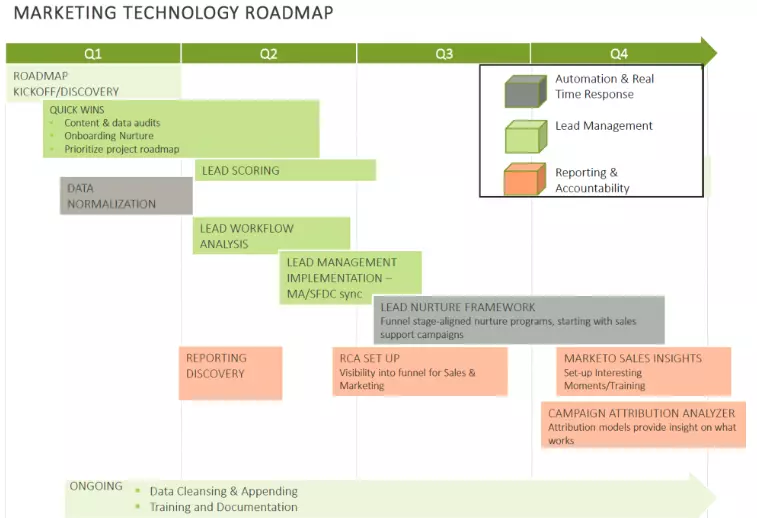Marketing Technology Roadmap
Definition
A marketing technology roadmap is a strategic plan that outlines the technology initiatives and projects necessary to achieve marketing goals and objectives.
Description
You need a roadmap for marketing to align marketing goals with technology initiatives, enabling organisations to prioritise investments and improve customer experiences. The structured outline provides a clear plan for implementing new technology and achieving business objectives, leading to greater efficiency and revenue growth.

Source: www.demandgen.com
Marketing teams prioritise and plan their technology investments and deployments over a set period, usually several years.
The roadmap typically includes a detailed analysis of the existing marketing technology stack and identifies areas where technology can improve the customer experience, increase efficiency, and drive revenue growth.
By creating a marketing technology roadmap, organisations can align their marketing strategies with their technology capabilities, enabling them to stay competitive, meet customer needs, and achieve their business objectives.
Importance of Marketing Technology Roadmap
A marketing technology roadmap is essential for several reasons:
- Aligns marketing goals with technology initiatives: By creating a roadmap, organisations can ensure that their marketing strategies are supported by the right technology, enabling them to achieve their goals more efficiently.
- Prioritises technology investments: A roadmap helps to prioritise technology investments, ensuring that limited resources are directed towards the most impactful initiatives.
- Improves customer experiences: By identifying areas where technology can improve the customer experience, organisations can deliver better customer experiences and increase customer satisfaction and loyalty.
- Enables revenue growth: A roadmap helps to identify technology initiatives that can drive revenue growth, such as marketing automation or personalization.
- Provides a clear implementation plan: The roadmap outlines the steps required to implement new technology, enabling organisations to plan and budget effectively and ensure successful deployment.
How to make a Marketing Technology Roadmap?
Here are the general steps to create a marketing technology roadmap:
- Define marketing goals: Identify the business objectives and goals the roadmap will support, such as increasing revenue, improving customer experiences, or optimising marketing operations.
- Assess current technology stack: Evaluate the existing marketing technology stack and identify areas where technology can be improved or optimised to better support marketing goals.
- Identify gaps: Identify technology gaps that must be filled to achieve marketing goals and prioritise them based on their impact and feasibility.
- Determine the budget: Estimate the budget required for each technology initiative and prioritise them based on the available resources and expected return on investment.
- Choose vendors: Research and select vendors or technology solutions that meet the requirements of each initiative.
- Plan implementation: Develop a detailed implementation plan for each technology initiative, including timelines, milestones, and resource requirements.
- Monitor and adjust: Monitor the implementation progress, measure the impact of the new technology on marketing goals, and adjust the roadmap as needed to ensure ongoing alignment with business objectives.
Future aspects of Marketing Technology Roadmap
The future of the marketing technology roadmap will likely include the following aspects:
- The increasing importance of AI and machine learning: AI and machine learning will become more prevalent in marketing technology stacks, enabling more advanced automation, personalization, and data analysis.
- The continued growth of marketing automation: Marketing automation will continue to grow, enabling marketing teams to automate repetitive tasks, improve efficiency, and deliver more personalised and relevant customer experiences.
- Greater emphasis on data privacy and security: With growing concerns over data privacy and security, marketing technology roadmaps must incorporate measures to protect customer data and comply with GDPR and CCPA.
- Integration of emerging technologies: Emerging technologies such as virtual reality, augmented reality, and voice assistants will become more integrated into marketing technology stacks, providing new opportunities for engaging and immersive customer experiences.
- Greater focus on omnichannel marketing: Marketing technology roadmaps must prioritise initiatives that support omnichannel marketing, enabling consistent and seamless experiences across all touchpoints.
Things to keep in mind while building Marketing Technology Roadmap
Here are some things to keep in mind while building a marketing technology roadmap:
- Focus on business objectives: Ensure that the marketing technology roadmap is aligned with the overall business objectives and marketing goals. The roadmap should support the organisation’s broader strategy and priorities.
- Involve stakeholders: Involve stakeholders from across the organisation in developing the marketing technology roadmap, including marketing, IT, sales, and customer service teams. This ensures buy-in and support for the roadmap’s initiatives.
- Prioritise initiatives: Prioritise the initiatives in the roadmap based on their impact and feasibility. Consider factors such as ROI, resource availability, and complexity when prioritising initiatives.
- Evaluate existing technology: Evaluate the existing marketing technology stack and identify areas where technology can be optimised or improved to better support marketing goals.
- Ensure scalability: Ensure that the technology initiatives in the roadmap are scalable and can support the organisation’s future growth and expansion.
- Consider integration: Consider how the new technology initiatives will integrate with existing systems and processes, and plan for integration and data migration accordingly.
- Develop a detailed implementation plan: Develop a clear plan for implementing each technology initiative, including timelines, milestones, and resource requirements. This helps ensure successful deployment and adoption.
Example:
Tata Motors is one of India’s largest automobile manufacturers. The brand’s marketing technology roadmap includes a plan to enhance the online presence. Tata Motors have invested in a more robust website and mobile app, including features such as a vehicle configurator, chatbot for customer support, and personalised content based on user behaviour.

The motor manufacturing leader, implements a marketing automation platform to automate and streamline marketing processes such as email marketing, social media advertising, and lead nurturing.
Tata Motors could use data analytics and machine learning to personalise the customer experience, such as recommending vehicles based on a customer’s previous interactions and preferences.
The motor brand creates virtual reality experiences to showcase their vehicles and provide immersive test drive experiences, enabling customers to experience the brand in a new way.
Tata Motors could leverage social media to engage with customers and build brand awareness, using tools such as social listening to understand customer sentiment and respond to feedback.
FAQs
What is a marketing technology roadmap?
A marketing technology roadmap is a strategic plan outlining how an organisation uses technology to achieve its marketing goals and objectives.
Why is a marketing technology roadmap essential?
A marketing technology roadmap is crucial because it helps organisations align technology initiatives with marketing goals, prioritise technology investments, and ensure ongoing optimization and alignment with business objectives.
What are some critical components of a marketing technology roadmap?
Some key components of a marketing technology roadmap include marketing goals and objectives, an assessment of the existing technology stack, identification of technology gaps, prioritisation of initiatives, a budget estimate, vendor selection, and a detailed implementation plan.
What are some future trends in the marketing technology roadmap?
Future trends in the marketing technology roadmap include increasing use of AI and machine learning, the continued growth of marketing automation, greater emphasis on data privacy and security, integration of emerging technologies such as virtual reality, and greater focus on omnichannel marketing.
How can organisations ensure success when implementing a marketing technology roadmap?
Organisations can ensure success when implementing a marketing technology roadmap by focusing on business objectives, involving stakeholders, prioritising initiatives, evaluating existing technology, ensuring scalability, considering integration, and developing a detailed implementation plan.





We would love to have your opinion.